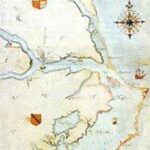Roanoke Island is a place of history as the English first settled there in 1585. But the mystery of what happened to the one hundred settlers is still not solved. Sir Walter Raleigh had sent one hundred men to Roanoke Island as he saw it as a place where English warships could be repaired because of the war they had with Spain at the time. However, one big problem existed upon arrival.
It was discovered that the island was nowhere near fertile enough to support the colonists and the Indians who lived nearby. Another problem was that the shallowed waters surrounding the island made it nearly impossible for warships to arrive there. The original colonists then returned to England, and Raleigh had dispatched another group of settlers to the abandoned island. After seeing for themselves that the site was abandoned, all but fifteen of them left to go back to England. Finally in 1587, Raleigh sent yet another group of colonists to Roanoke Island. Those ships were headed to what is now Chesapeake Bay on the northern coast of present-day Virginia. The ships reached what is now known as the Outer Banks in North Carolina in the summer of 1587. The commander of the ships refused to take them to their destination and left them on Roanoke Island. John White, who had been a part of the first settlers in Roanoke, went back to England that summer for supplies. Because of England being at war with Spain, White would not be able to go back to Roanoke Island for three years.
White finally made it back to Roanoke Island in August of 1590 to find it abandoned. He was expected to see family and friends on arrival, but the one hundred settlers that were supposedly still there were gone by the time he got back. The only clue that White was able to find on the island to their whereabouts was the word “Croatoan” engraved on a tree. Croatoan, or Hatteras, Indians were considered very friendly people who lived on an island just south of Roanoke Island. White then tried to locate the colonists, but bad weather kept him from conducting a thorough search for them. He instead returned to England later that year.
Many theories over the last 400 years have been used as an explanation for the disappearance of the colonists. The most often accepted theory is that the colonists became part of the Croatoan tribe that lived in North Carolina. Another theory is that the colonists had tried to move back to Chesapeake Bay, which was the intended destination. However, they were met with stiff resistance by the Indians of the island, and they later perished as a result. There was no signs of struggle or fighting on Roanoke Island after White returned in 1590.
In 1999, scientists were able to theorize what may have happened to the colonists. Scientists now say that the colonists has suffered through the worst drought in over eight centuries at the time. The evidence they used to support this was from the 800-year old cypress trees on the island as they studied the moisture-sensitive rings to on them to make the claim. This is also why some believe the colonists starved to death because this would have meant a massive food shortage for the island. Furthermore, the drought was said to have lasted three years between 1587-1589.
Another theory that has been used was that they were killed by the Powhatan, leader of the Powhatan Tribe, because the colonists were living with the Chesapeake Tribe, who refused the confederacy of his tribe. The leader of the Powhatan Tribe had supposedly told John Smith, who was the captain of the Jamestown colonists, that he killed them and had iron implements to prove it. But, no bodies were ever found, so many do not believe this happened to the colonists.
Some still theorize that the colonists refused to wait any longer for a fleet to take them back to England, and they risked going back on their own. They were left ships to explore the island by White, but perished in trying to get back to England. But no ships have ever been found to support this claim either.
In 1998, East Carolina director of Archaeology Office David Phelps, discovered a signet ring that connects the colonists with the Native Indians on Hatteras Island. The face of the signet depicts a walking lion, which is a symbol of English authority that is normally worn by noblemen. It has been traced back to Kendall family, who were part of the first settlement in 1585 and 1586. One was named simply Master Kendall and the other was Abraham Kendall. It is also very possible that both Kendalls were one in the same. The connection between the Kendalls and Roanoke Island is very strong, but it is not entirely known yet if the signet and them are correct.
Many theories have surrounded the disappearance of the Lost Colony of Roanoke Island. The evidence that has been presented in recent years may tell us more about the possible severe drought that took place. But further evidence may be discovered with the signet that was found as well. Over 400 years later, it is not entirely known what happened to the colonists of Roanoke Island. One thing for sure is that they were never seen again by Europeans after White had left to go back to England for supplies in 1587. The Native Indians may have been the last to see them alive, but this is something that may never be solved after such a long period of time.


